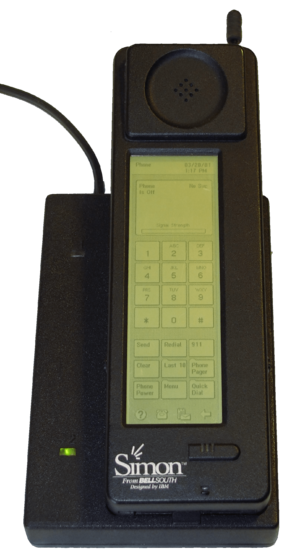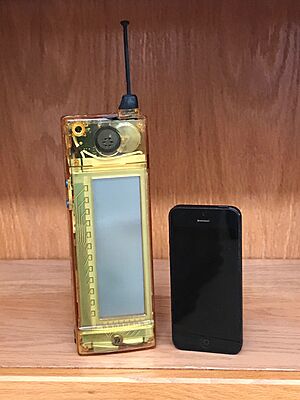IBM Simon facts for kids

The Simon Personal Communicator shown in its charging base
|
|
| Brand | BellSouth (designed by IBM) |
|---|---|
| Developer | IBM |
| Manufacturer | Mitsubishi Electric Corp. |
| Compatible networks | AMPS |
| First released | 1994 |
| Availability by country | United States August 16, 1994 (BellSouth Cellular) |
| Discontinued | February 1995 |
| Units sold | 50,000 |
| Model before | Angler (code name) |
| Type | Smartphone |
| Form factor | Brick |
| Size |
|
| Weight | 18 oz (510 g) |
| Operating system | Datalight ROM-DOS |
| CPU | NEC V30HL, 16 MHz, 16-bit, 8086-compatible CPU as part of Vadem VG230 System on a chip |
| Memory | 1 MB PSRAM (2× Hitachi HM658512LTT) 32 KB SRAM (Sony CXK58257) |
| Storage | 1 MB NOR Flash (Intel/Hitachi) expanded to 2 MB by Stacker compression + 32KB BIOS NOR Flash |
| Removable storage | Optional PCMCIA Flash RAM cards |
| Battery | 7.5V NiCad |
| Data inputs |
|
| Screen | 4.5 in × 1.4 in (114 mm × 36 mm), 160 × 293 pixel CGA monochrome backlit LCD |
| Connectivity |
|
The IBM Simon Personal Communicator, often called the IBM Simon, was a super cool handheld device. It had a touchscreen and was designed by IBM. Mitsubishi Electric helped make it. Even though the word "smartphone" wasn't used until 1995, many people now call the Simon the very first true smartphone.
BellSouth Cellular Corp. sold the IBM Simon in the United States. It was available from August 1994 to February 1995. About 50,000 units were sold during that time. The Simon was the first PDA (which is like a small computer) that could also make phone calls. However, its battery only lasted about an hour. Also, newer flip phones became much thinner. These reasons led to the Simon no longer being sold.
Contents
History of the First Smartphone
Back in the day, computer chips were getting much smaller. Wireless mobile networks were also becoming more common. An engineer at IBM named Frank Canova realized something exciting. He saw that these new technologies could fit into small, handheld devices.
The Sweetspot Prototype
On November 16, 1992, IBM showed off a test device. They called it "Sweetspot." This happened at a big computer show called COMDEX in Las Vegas. The Sweetspot prototype was amazing because it combined a mobile phone and a PDA. This meant you could make and get phone calls. You could also send faxes, emails, and even cellular pages.
The prototype had many helpful features, just like a PDA. It had a calendar, an address book, and a notepad. It also showed off other digital services that weren't common yet. These included maps, stock prices, and news. People at the COMDEX show and the news reporters were very interested. The day after Sweetspot was shown, USA Today put a photo on its front page. It showed Frank Canova, the inventor, holding the Sweetspot.
From Prototype to Product
After the successful show, IBM started working on a product to sell. They gave it the code name "Angler." IBM first asked Motorola to make the device. But Motorola said no. They worried that IBM might become a competitor in making phones. So, IBM then asked Mitsubishi Electric to build it. Mitsubishi added some of its own wireless PDA and phone technologies to the IBM design.
BellSouth executives gave the final product its official name. They called it the "Simon Personal Communicator." It was first shown to the public at the Wireless World Conference in November 1993. BellSouth Cellular had planned to start selling Simon in May 1994. But there were some problems with the software. Because of this, the Simon wasn't available until August 16, 1994.
Price and Sales
When it first came out, BellSouth Cellular sold the Simon for US$899. This price was with a two-year service contract. If you didn't want a contract, it cost US$1099. Later, the price dropped to US$599 with a two-year contract. BellSouth Cellular sold about 50,000 units. This happened during the six months the product was available.
Simon's Cool Features
The Simon could do more than just make and receive phone calls. It could also send and get faxes, e-mails, and cellular pages. It had many useful apps built-in. These included an address book, a calendar, and an appointment planner. There was also a calculator, a world time clock, and an electronic notepad. You could even write notes on the screen with a stylus.
The Simon had a liquid-crystal display (LCD) screen. It also supported PC Cards, which were like early memory cards. Inside, it had special computer chips. These chips helped it run all its features.
Helpful Accessories
When you bought a Simon, it came with a few things. You got a charging base station to power it up. It also came with a nickel-cadmium battery and a protective leather cover.
You could also buy extra accessories. One was a PCMCIA pager card made by Motorola. Another was a special cable to connect it to a computer. This cable let you access files from your computer. There was also an adapter cable that let you make calls using a regular home phone line. This helped users save money on expensive cell phone bills. It also let them make calls where there was no cell service in 1994.
How Simon Worked
The Simon used a special file system called ROM-DOS. It also used a program called Stacker to compress files. IBM created a unique touchscreen system for the Simon. You wouldn't see a complicated computer screen. This easy-to-use system was called the Navigator.
You could add more apps to the Simon. You could do this by putting in a PCMCIA card. Or you could download an app directly to the phone's memory.
One company, PDA Dimensions, made an app called "DispatchIt." This was the only app made for the Simon by another company. It was an early version of what we now call "Remote Desktop" software. This app was quite expensive. The computer software cost US$2,999, and each Simon app cost US$299.
See also
- IBM PCradio



